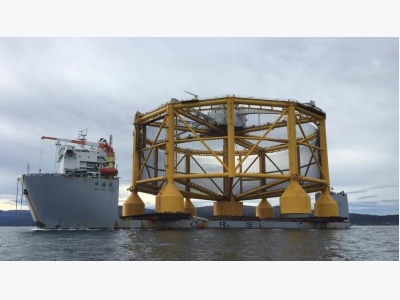Giant farm operational within weeks

OCEAN Farm 1, SalMar’s giant deep sea fish farm, could be in at least experimental production within a couple of months.
The world’s first farm of its kind, measuring 68m high, has just arrived in Trøndelag, Norway, following its long journey from the eastern Chinese yard near Quingdao City, where it was completed earlier in the summer.
It cost more than NOK 700 million and will be operated by Ocean Farming, a subsidiary of SalMar.
SalMar CEO Trond Williksen said he was deeply proud of what has been achieved.
‘Ocean Farm was delivered on time from its Chinese yard. Of course there were a few technical challenges as there always are with brand new technology. Now the work really begins.’
The offshore company Solstad Farstad has been given the task of positioning and anchoring Ocean Farm 1.
When this is completed, SalMar and its sub-contractors will get to work on making what is the world’s first semi-submersible farm fully operational. It could be taking its first fish in a matter of weeks if everything goes according to plan.
Thor Hukkelås, head of Aquaculture Systems and Technology at Kongsberg Maritime, one of the sub-contractors, said: ‘First, we need to get all systems up and running and check that all of the automation and communication equipment works before the first fish is released into the cage.’
Meanwhile, SalMar recently announced a significant rise in its second quarter sales and operating profits thanks to the high prices of salmon.
The group’s Q2 operational EBIT totalled NOK 983.0 million, up from NOK 670.7 million in the previous quarter and from NOK 731.8 million on the same period last year.
Overall, the SalMar group achieved an operating profit per kg gutted fish of NOK 28.12, up 10 per cent on the previous quarter and a hike of 24 per cent compared with the second quarter last year.
Williksen said: ‘SalMar’s strong results derive from continued good operations and yet another quarter of high salmon prices.
‘The biological situation was slightly better than in the same period last year, but managing the sea lice issue remains challenging.
‘SalMar has implemented a number of initiatives to improve the situation, in combination with a continued increasing focus on fish welfare.
‘Measures to manage the lice situation are costly, and a high treatment frequency rate will negatively affect production costs in coming quarters.’
The group generated gross operating revenues of NOK 2.9 billion in the quarter, up from NOK 2.3 billion on Q2 last year.
It harvested 35,000 tonnes, compared with 32,200 tonnes in Q2 2016. Operational EBIT totalled NOK 983.0 million, up from NOK 731.8 million on Q2 2016.
In Q1 2017 the group harvested 26,300 tonnes of salmon and made an operational EBIT of NOK 670.7 million.
This year, SalMar plans to harvest around 131,000 tonnes in Norway, with 83,000 tonnes being harvested in Central Norway and 48,000 tonnes in Northern Norway.
Its subsidiaries, Scottish Sea Farms (Norskott Havbruk) and Arnarlax in Iceland are expected to harvest 30,000 tonnes and 10,000 tonnes respectively.
Related news
 An engineer’s design for a classroom aquaculture-aquaponics system
An engineer’s design for a classroom aquaculture-aquaponics system Aquaculture system showing three production tanks, pump sump, Bubble washed-bead filter, automatic feeders and monitoring system.
 Walleye and saugeye growing successfully indoors
Walleye and saugeye growing successfully indoors The walleye (Sander vitreus, previously known as Stizostedion vitreum) is a freshwater perciform (family Percidae) fish native to the Northern United States
 Sturgeon aquaculture in British Columbia: Are we there yet?
Sturgeon aquaculture in British Columbia: Are we there yet? While salmon will undoubtedly remain the backbone of B.C. seafood production, there continues to be interest in emerging species, including freshwater trout